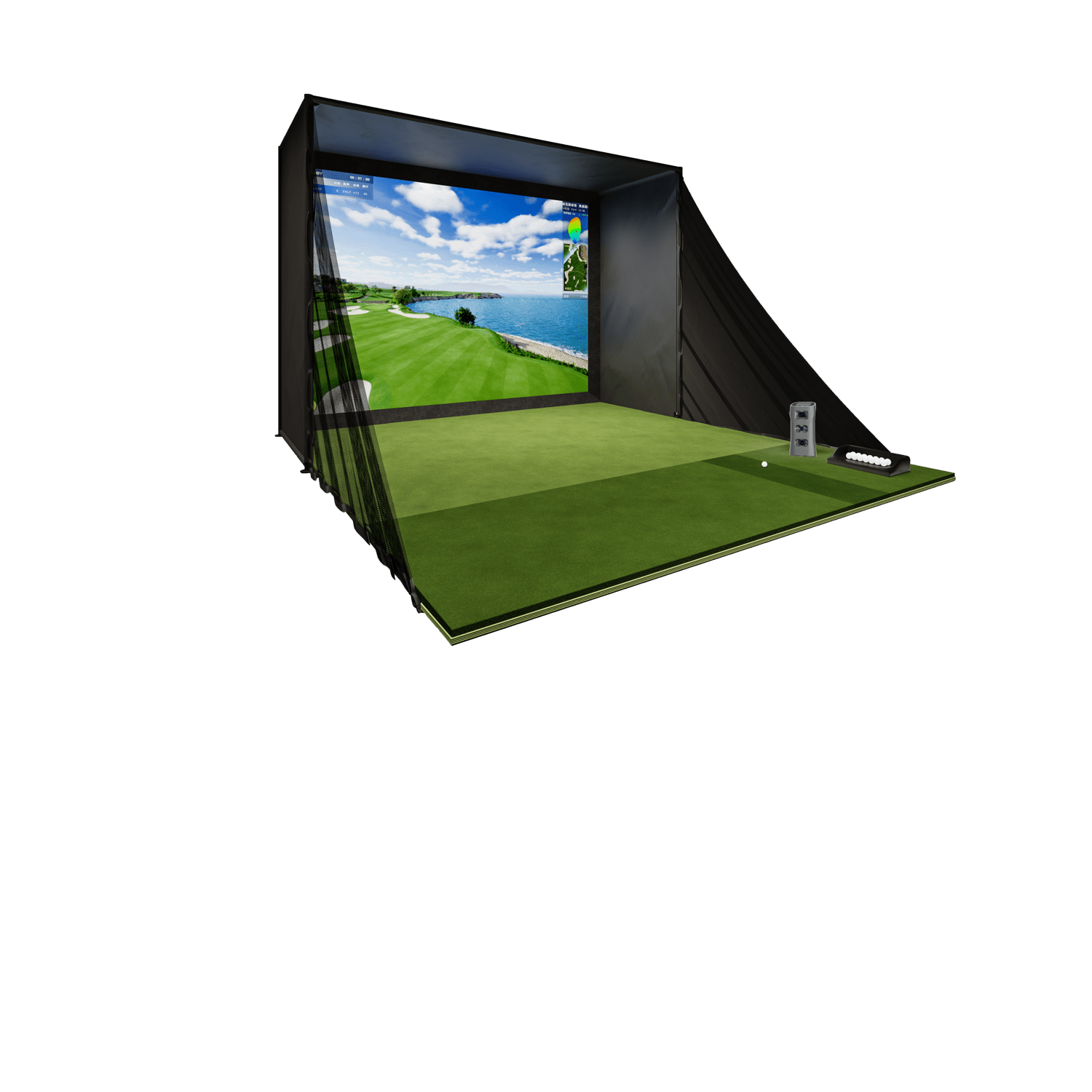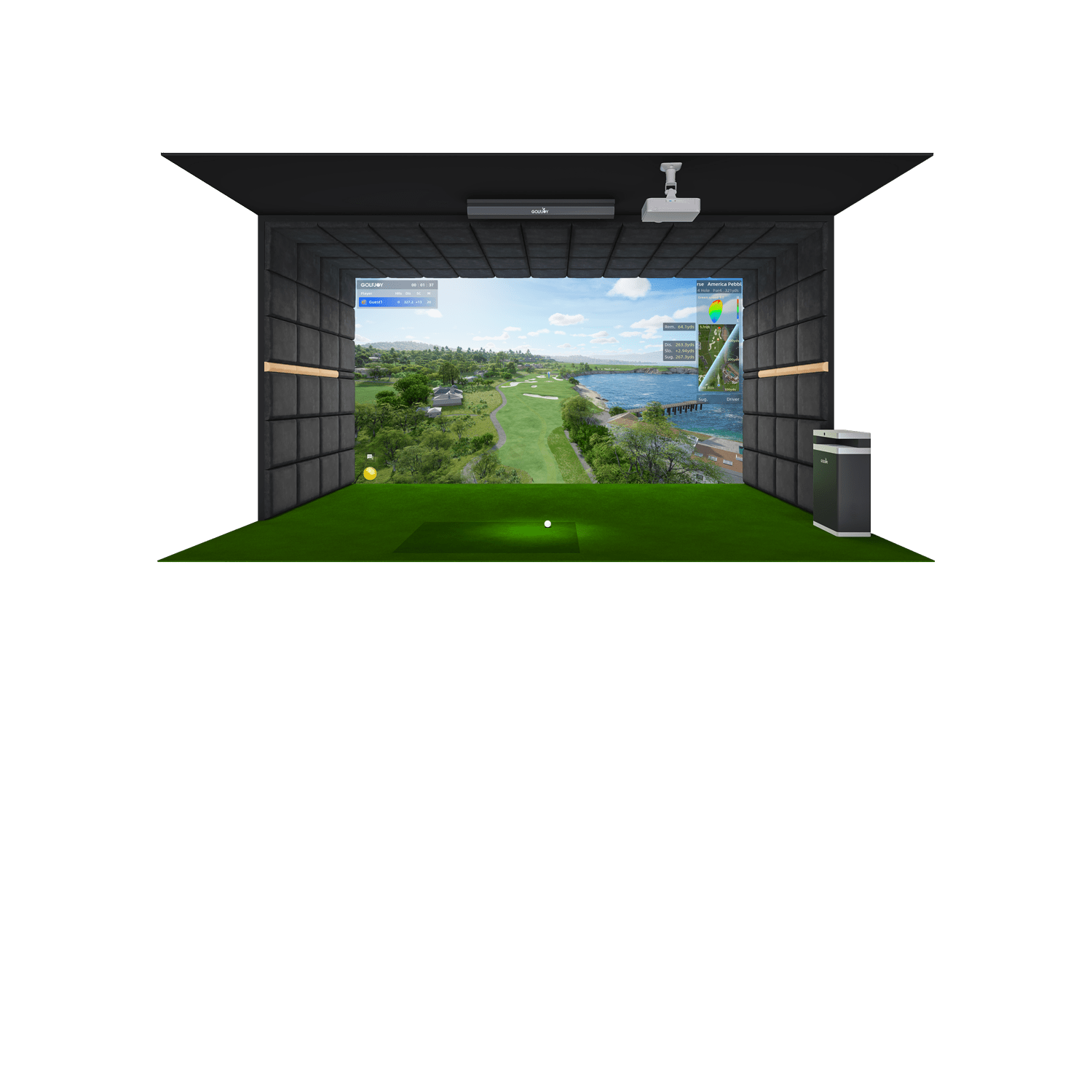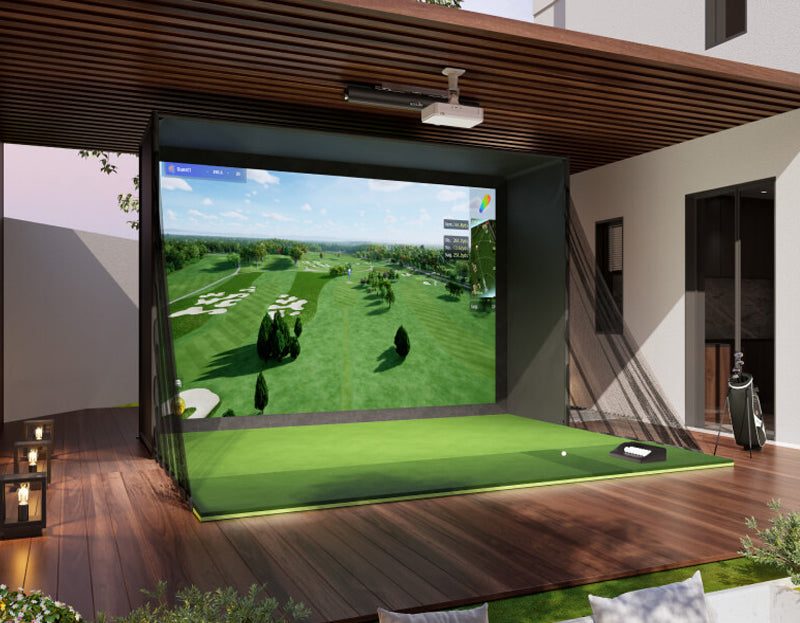Golfers today want accurate data wherever they play — not just inside a simulator room. That’s where a portable launch monitor comes in, offering the flexibility to track ball flight, club speed, and spin whether you’re at the range, in the backyard, or traveling. A golf portable launch monitor combines convenience with performance, giving players tour-level insights without being tied to a fixed setup. Costs and features vary widely, from budget-friendly options that focus on basic numbers to premium models with advanced shot analytics, video feedback, and simulator integration. In this guide, we’ll break down pricing, accuracy, and the best picks for 2025 so you can find the right tool for your practice.
What Is a Portable Launch Monitor?
A portable launch monitor is a compact device designed to measure key swing and ball data wherever you play. Unlike large, ceiling-mounted systems, a golf portable launch monitor sits on the ground behind or beside the ball, using radar or camera sensors to capture launch angle, spin, and golf ball speed.
When comparing a portable launch monitor vs overhead launch monitor, the main difference is flexibility. Overhead models are installed permanently in simulator rooms and provide top-down tracking for indoor play, while portable launch monitors let you move between the range, backyard, or simulator bay without complicated setup.
These lightweight devices have become a favorite for golfers who want accurate feedback without dedicating an entire room to technology. Whether you’re fine-tuning your swing at home or taking practice sessions outdoors, a portable monitor offers pro-level insights in a travel-friendly package.
Price Ranges for Portable Launch Monitors
When comparing portable launch monitor price, the main drivers are tracking technology (radar vs high-speed camera), the number of lenses/sensors, and how many data points the device produces. Below is a practical price-tier breakdown of popular portable launch monitors (2025), with tracking type, lens/radar form factor, and approximate data points to help you compare options quickly.
| Price Tier | Model | Tracking Type | Lenses / Radar | Approx. Data Points | Notes |
|---|---|---|---|---|---|
| Entry ($200–$600) |
Rapsodo MLM ($699) |
Radar + Camera | Single camera | ~10 | Budget-friendly starter; reliability varies. |
| Entry ($200–$600) | Rapsodo MLM 2 Pro ($699) | Radar + Camera | Single camera | ~15 | Good value; consider protective case. Some models work best with recommended balls. |
| Entry ($200–$600) | Swing Caddie SC4 Pro ($499) | Radar | Radar sensor | ~8 | Simple display; ideal for casual practice. |
| Entry ($200–$600) | Garmin Approach R10 ($599) | Radar | Radar sensor | ~10 | Affordable; mobile and portable, popular for casual use. |
| Mid ($1,000–$3,000) | FlightScope Mevo Gen2 ($1,199) | Radar | Radar sensor | ~16 | Good budget mid-range option; limited club data. |
| Mid ($1,000–$3,000) | FlightScope Mevo+ ($2,199) | Radar | Radar sensor | ~20 | Solid accuracy for practice and fitting. |
| Mid ($1,000–$3,000) | SkyTrak+ ($1,995) | High-speed camera (with Doppler assist) | 2 cameras | ~20 | Primarily camera-based → indoor focus; widely used for simulator integration. |
| Mid ($1,000–$3,000) | GOLFJOY GDS PRO ($2,199) | High-speed camera | 2 cameras | 27 | AI-enhanced; strong mid-range accuracy. |
| Upper Mid / Near Premium ($3,000–$5,000) | Uneekor Eye Mini ($4,500) | High-speed camera | 2 cameras | ~22 | Reliable indoor data for serious golfers. |
| Upper Mid / Near Premium ($3,000–$5,000) | Golfzon Wave ($3,995) | Radar + Camera | Hybrid | ~20 | Hybrid approach combining radar and cameras. |
| Upper Mid / Near Premium ($3,000–$5,000) | Garmin Approach R50 ($4,999) | Radar | Radar sensor | ~20 | Compact premium radar monitor. |
| Upper Mid / Near Premium ($2,000–$3,000) | GOLFJOY Spica 3 ($3,199 )* | High-speed camera | 3 cameras | 27 | 2025 release; user data: near-TrackMan/Foresight accuracy at mid price. |
| Premium ($5,000+) | Foresight GC3 ($6,999) | High-speed camera | 3 cameras | ~25 | Trusted high-accuracy camera system for simulators. |
| Premium ($15,000+) | TrackMan 4 / TrackMan iO | Radar (with camera support) | Dual radar / radar + cameras | 30+ | Tour-level performance; commercial standard. |
Notes: prices and specs above are consolidated from public product listings and reviews (sources include model pages and industry roundups).
Features That Matter Most
When choosing a portable launch monitor, understanding which metrics really improve your golf game is essential. The most valuable data for players who want to get better includes ball speed, club head speed, carry distance, and spin rates. These numbers let you see how efficiently you’re transferring energy from club to ball and help you tune your launch conditions for consistent performance. For example, working on the ratio of ball speed to club head speed (often called “smash factor”) is one of the fastest ways to track ball striking quality.
Another key factor is where you plan to practice. Some models excel indoors, using cameras and short-range radar to measure ball speed golf data without needing a lot of flight distance. Others are optimized for outdoor ranges where they can track the full flight of the ball. If you plan to switch between environments, choose a unit that specifically supports both indoor and outdoor use, so you don’t lose accuracy in one setting.
Finally, accuracy should be compared with overhead launch monitors used in full simulator rooms. The best modern portable launch monitors now rival ceiling-mounted systems in precision, giving you detailed ball and club data with the benefit of mobility. This means you can enjoy nearly the same level of insight as a professional indoor setup, but with a device that fits in your bag and can travel anywhere you play.
Portable vs Overhead Launch Monitors
When you weigh portable launch monitor vs overhead launch monitor, you’re really deciding between mobility and convenience on one side and maximum accuracy and full-room integration on the other. A golf portable launch monitor is built for flexibility — practice anywhere, quick setup, travel-friendly — while an overhead golf launch monitor is designed as a permanent, ceiling-mounted brain for simulator rooms and pro fitting bays. Below I break the tradeoffs down so you can pick the right system for your goals.
Pros & Cons
Portable launch monitors — pros
-
Mobility: easy to carry, set up at the range, backyard, or indoors.
-
Fast setup: most take minutes, not hours — great for casual practice.
-
Lower entry cost: portable launch monitor price ranges let many players start with useful data without a large room buildout.
-
Good for on-the-go players and coaches who travel.
-
Many units pair with phones/tablets for video + data overlays.
Portable launch monitors — cons
-
Slightly more sensitive to environmental factors (wind, sun, lighting).
-
Some radar-only models struggle with spin or short indoor carry; camera models can be limited by indoor ceiling reflections or lighting.
-
Generally fewer simultaneous data channels than top overhead systems (though modern tri-camera portables are narrowing the gap).
-
Ball/ball-type requirements: a few portables give best readings only with specific balls.
Overhead launch monitors — pros
-
Superior multi-metric accuracy (club-and-ball data, spin, precise launch vectors) especially when paired with calibrated simulator enclosures.
-
Optimized for indoor simulator rooms — consistent geometry and lighting improves repeatability.
-
Better for club fitting and commercial use: multi-bay installations and pro-level analytics.
-
Seamless integration with high-end software and multi-camera rigs.
Overhead launch monitors — cons
-
High cost: installation + enclosure + projector + PC adds up (see commercial indoor golf simulator prices).
-
Fixed installation — not portable.
-
Requires space and often professional installation and ongoing support.
-
Less flexible if you want to practice outdoors or travel.
Which setup suits home users vs commercial facilities?
Home users (most cases)
-
If you want practice flexibility, a mid-range portable (think quality camera or hybrid radar + camera unit) is usually the best value. It gives the core metrics you need — ball speed, carry, smash factor, basic spin — at a much lower portable launch monitor price than a full overhead install.
-
If you have a dedicated spare room with suitable ceiling height, and you care deeply about club fitting or the absolute best repeatability, an overhead golf launch monitor (or wall/ceiling mounted camera system) in a proper enclosure will deliver a more consistent simulator experience. That said, overhead setups generally move you into the mid-to-high budget brackets.
Serious home players / semi-pro / coach
-
Consider a high-end portable tri-camera or dual-camera system (some new portables now offer 20+ data points) or a soft-mounted overhead if you have the budget and space. These give near-simulator level accuracy without full commercial installation.
Commercial facilities / clubs / fitting centers
-
Overhead systems are usually the right choice because they: handle heavy daily use, support multi-bay integration, offer pro-grade analytics for fitting, and provide the polished customer experience people expect in a paid facility. The investment is larger, but the ROI is clearer in commercial settings.
Practical tips when choosing
-
If you want both worlds: some businesses use a portable for demos and travel, and an overhead for the in-shop fitting experience.
-
Check the environment: indoor ceiling height, lighting, and whether you need outdoor capability.
-
Compare data points you actually use: if you train primarily on ball speed golf and smash factor, many mid-range portables are plenty. If you require club face angle, precise spin axis, and ultra-tight repeatability, overhead systems still have the edge.
-
Try before you buy: demo a unit (or a simulator bay) to see how readings compare in your space — accuracy can be surprisingly context-dependent.
Quick comparison (at a glance)
-
Mobility: Portable ✅ / Overhead ❌
-
Best for travel: Portable ✅
-
Best for club fitting & commercial accuracy: Overhead ✅
-
Typical cost range (broad): Portable = $200 → $5,000+ (depends on features) ; Overhead = $10,000 → $30,000+ (room + hardware + installation)
-
Recommended if you care about: casual practice & flexibility → portable; highest-fidelity fitting & pro venues → overhead.
In short — think about where you’ll use it most. For most golfers who want great practice without a permanent room buildout, a portable launch monitor is the pragmatic, cost-effective choice. If your mission is professional fitting, training centers, or the absolute highest repeatability, look at the best overhead launch monitors and plan for a dedicated simulator room.
How to Choose the Right Portable Launch Monitor
Choosing the right portable launch monitors is easier when you break the decision into three steps: define your purpose, match features to your budget, and evaluate space and portability. The guide below explains each step and offers a practical checklist so you can find a device that fits your practice goals or golf simulator setup.
1) Clarify Your Primary Goal (Practice · Entertainment · Fitting)
-
Practice & Skill Development – Prioritize repeatable, reliable data: ball speed, club head speed, carry distance, spin, and smash factor (ball speed to club head speed). Look for models that store sessions, export data, or sync with training apps.
-
Entertainment / Home Simulation – If social play and fun matter most, software ecosystem, multiplayer options, and lag-free graphics may outweigh absolute precision.
-
Club Fitting / Professional Use – Choose units that capture full club metrics (face angle, attack angle, path, spin axis). High-speed camera or hybrid radar + camera tech delivers the stability pros need.
2) Map Features to Your Budget
-
Entry Level ($200–$600) – Suited for casual golfers; expect basic ball speed and carry estimates. Convenience and price trump deep analytics.
-
Mid-Range ($1,000–$3,000) – The sweet spot for most golfers. Better accuracy, more data points (spin, smash factor, some club info), and stronger indoor/outdoor performance.
-
Premium ($5,000+) – Nearly fitting-grade, offering rich club/ball data, low latency, and manufacturer calibration services—perfect for coaches, studios, or serious amateurs.
3) Space & Portability
-
Indoor vs Outdoor – Camera-based devices excel indoors but may need controlled lighting; radar units love open space but can be wind-sensitive. If you’ll alternate, pick a dual-mode monitor.
-
Size & Weight – Under 3 lbs with a sturdy case makes travel easy.
-
Battery Life – 8–12 hours helps avoid interruptions during long practice sessions.
-
Setup & Calibration – Look for clear alignment aids or auto-leveling; confirm whether it requires special balls or reflective dots.
-
Simulator Compatibility – Check if the model integrates smoothly with TGC, E6, GSPro, or other platforms in your golf simulator setup.
4) Pre-Purchase Checklist
-
Confirms core metrics: ball speed, club head speed, carry, spin, smash factor
-
States tracking tech (radar, single/dual/tri-camera, or hybrid)
-
Lists indoor/outdoor modes
-
Shows supported simulator software
-
Includes protective case or stand
-
Battery capacity meets your needs
-
Clarifies ball requirements or calibration needs
-
Provides warranty, firmware updates, and responsive support
-
Has trustworthy user reviews and third-party accuracy tests
5) Quick Buying Tips
-
Casual practice & light sim play: pick a mid-range hybrid or radar unit—good accuracy, easy setup, flexible use.
-
Serious training: favor models with more data points, historical storage, and consistent spin/club readings.
-
Coaches or studios: a premium or overhead solution offers the stability and feature depth for lessons or fittings, while a portable monitor serves as a travel-friendly backup.
Recommended Portable Launch Monitors in 2025
If you’re looking for the best value in portable launch monitors, the standout for 2025 is undoubtedly GOLFJOY. Its newest models — the GDS PRO and the Spica 3 — combine cutting-edge technology with pricing that makes sense for ambitious golfers.
The GDS PRO uses dual high-speed cameras with AI-enhanced tracking, while the Spica 3 introduces a triple-camera system capable of capturing up to 27 data points with incredible precision. Independent reviews and official tests show its accuracy is nearly indistinguishable from premium systems such as TrackMan or Foresight, yet it comes in at a fraction of their cost (around $2,199–$3,199).
For golfers who want professional-level feedback without spending $5,000–$20,000 on commercial hardware, GOLFJOY delivers the perfect balance of accuracy, portability, and price. Its straightforward setup, detailed video guides, and optional remote support mean you can start practicing within minutes — at home, on the range, or even while traveling.
If your goal is to sharpen your swing and get dependable ball speed, carry, and spin data wherever you play, GOLFJOY’s portable launch monitors are a clear winner for 2025.

Portable launch monitors offer the perfect balance of cost and convenience, giving golfers access to reliable data anywhere they practice. By choosing the right device, you can track ball speed, carry distance, and spin without committing to a full simulator setup.
For players seeking professional-level accuracy at a reasonable price, GOLFJOY’s portable launch monitors stand out as a smart investment. They provide dependable feedback and effortless setup, helping you elevate your game wherever you play.
FAQ
How accurate are portable launch monitors compared to overhead models?
Modern portable launch monitors have become impressively precise, with many matching the ball-flight data of premium overhead golf launch monitor systems. Mid- to high-tier devices such as GOLFJOY or FlightScope Mevo+ often deliver ball speed, carry distance, and spin numbers that are within a few percent of top commercial units. However, overhead models still lead for ultra-detailed club data and tracking in teaching bays or fitting studios.
Can portable launch monitors be used indoors and outdoors?
Yes. One of the biggest advantages of portable launch monitors is their flexibility. Most work equally well at the driving range, in your backyard, or inside a golf simulator setup. When using them indoors, ensure you have enough space for ball flight (usually 8–10 ft) and proper lighting if the device uses cameras.
What metrics should a good portable launch monitor provide?
Look for essential data such as ball speed, club head speed, carry distance, launch angle, and spin rate. Higher-end units may also track smash factor, apex height, descent angle, or even club path. The more complete the metrics, the easier it is to pinpoint swing improvements and optimize equipment.
Do more expensive models always mean better accuracy?
Not always. Price often reflects extra features (video replay, simulation software, advanced club data) rather than a big leap in precision. Many golfers find mid-range devices like GOLFJOY or SkyTrak+ deliver accuracy close to premium systems at a fraction of the cost, making them an excellent value.
What’s the difference between a portable and a commercial launch monitor?
A golf portable launch monitor is designed for individual players who want performance in a compact, travel-friendly package. Commercial launch monitors — such as the best overhead launch monitors used in teaching studios — are built for heavy daily use, offer extensive club-head analytics, and integrate with professional simulator enclosures. For most golfers, a quality portable unit balances portability, data, and price without requiring a full studio build.










Leave a comment
All comments are moderated before being published.
This site is protected by hCaptcha and the hCaptcha Privacy Policy and Terms of Service apply.